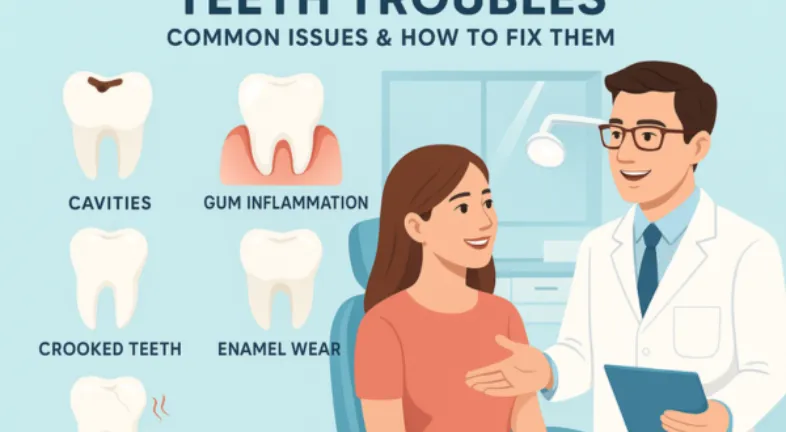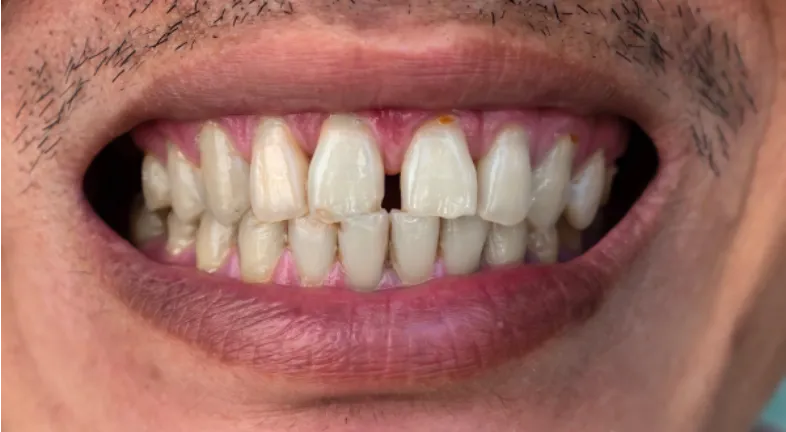
Maintaining good oral health goes hand in hand with your general health, but at one point or another, most people will deal with a few common tooth issues. Whether from tooth decay or sensitive teeth, dental issues can be uncomfortable and affect your everyday life. This blog will explore several tooth problems and their treatments. By learning about dental problems and their treatments, you'll be more capable of proactively caring for your oral health and being on your way to a brighter smile and a healthier you.
Tooth issues can range from minor annoyances to serious dental concerns. Some of the most common tooth problems include poor tooth alignment , cavities, gum disease, tooth sensitivity, and enamel erosion.
Tooth decay, or cavities, is one of the most common tooth problems affecting people of all ages. It develops when bacteria in the mouth feed on sugars and produce acids that erode the tooth enamel, the protective outer layer of your teeth. In its early stages, you may notice white spots or mild sensitivity, but if left untreated, cavities can lead to intense pain, infection, and even tooth loss. Common symptoms include toothache, spontaneous pain, sensitivity to hot or cold foods, visible pits or holes, and dark discoloration.
Poor oral hygiene, frequent sugary or acidic food intake, dry mouth, and certain conditions like diabetes increase the risk of cavities. To prevent this common dental problem, brush twice daily with fluoride toothpaste, floss to remove plaque between teeth, and limit sugary snacks. For children or high-risk adults, dental sealants can offer extra protection. Advanced decay, however, may require professional treatments such as fillings, crowns, or root canals to restore tooth function and prevent further damage.
Gum disease is another major cause of tooth issues, starting as gingivitis—a mild gum inflammation, and potentially progressing to periodontitis, which can lead to bone damage and tooth loss. The condition arises from plaque buildup, poor oral care, smoking, and sometimes genetics. Symptoms often include swollen or bleeding gums, persistent bad breath, receding gums, and loose teeth in severe cases.
The main cause of gum disease is bacterial plaque buildup, worsened by smoking, poor nutrition, and hormonal fluctuations. Maintaining proper oral hygiene, using antiseptic mouthwash, and scheduling regular dental cleanings can stop early gum problems from worsening. Advanced cases may require deep cleaning procedures such as scaling and root planing to remove bacteria below the gum line and promote healing.
Tooth sensitivity causes sharp pain or discomfort when consuming hot, cold, sweet, or acidic foods. This issue occurs when the enamel wears down or gums recede, exposing the dentin underneath. Common symptoms include discomfort while brushing or temporary pain triggered by temperature changes.
Frequent causes include aggressive brushing, gum recession, acidic diets, and underlying problems such as decay or cracked teeth. The best ways to manage sensitivity are by using toothpaste specifically made for sensitive teeth, avoiding acidic foods, and brushing gently with a soft-bristled toothbrush. For ongoing or severe sensitivity, a dental checkup is essential to address enamel erosion or hidden cavities.
Cracked or chipped teeth can cause significant discomfort or infection if ignored. Symptoms include sharp pain when chewing, sensitivity to hot or cold, visible cracks, and occasional swelling near the damaged tooth.
Common causes include sports injuries, teeth grinding (bruxism), biting on hard foods like ice or nuts, and weakened enamel. Solutions vary depending on the severity—minor chips can be treated with dental bonding or fillings, while larger fractures may require crowns or veneers. Wearing a night guard for bruxism and avoiding hard foods are key preventive measures.
Misaligned or crooked teeth affect both dental function and appearance. They can cause bite issues, uneven wear, and make cleaning difficult, leading to decay or gum disease. Typical symptoms include crowded or overlapping teeth, difficulty chewing, jaw pain, or increased plaque buildup.
Misalignment can stem from genetic factors, premature loss of baby teeth, thumb-sucking habits, or jaw injuries. Solutions include braces or clear aligners to straighten teeth and retainers to maintain their position after orthodontic treatment.
Caspersmile Clear Aligners are an advanced, at-home solution for such alignment issues. These transparent trays gradually reposition teeth without the need for traditional metal braces. With All-Day (22 hours/day) and Nightlong (10 hours/night) wear options, they provide flexibility for different lifestyles. Caspersmile aligners are ideal for correcting mild to moderate misalignments, offering a discreet, affordable, and comfortable way to achieve a perfect smile. However, for severe alignment problems or missing teeth, in-office orthodontic care may be necessary.
Persistent bad breath often signals poor oral hygiene or an underlying health problem. Halitosis results from bacterial buildup on the tongue, gum disease, or trapped food particles. Common symptoms include an unpleasant odor, dry mouth, and gum inflammation.
The causes include infrequent brushing, tobacco use, dry mouth, and infections in the mouth or sinuses. To fix this issue, brush and floss daily, use mouthwash, and clean your tongue regularly. Staying hydrated and addressing dental or medical problems early can help prevent recurring bad breath.
Tooth erosion occurs when acids from foods, drinks, or medical conditions like GERD (acid reflux) wear down the enamel. This can cause increased sensitivity, discoloration, and structural damage over time. Symptoms include yellowing, thin edges, and cracks or chips in the teeth.
Common causes include acidic diets, soft drinks, reflux, and dry mouth. Solutions include reducing acidic intake, using fluoride toothpaste to strengthen enamel, and avoiding brushing immediately after acidic meals. In advanced cases, bonding or veneers may be required to restore the tooth’s appearance and function.
Bruxism, or teeth grinding, is a widespread problem that often occurs during sleep or stress. It leads to enamel wear, fractures, jaw pain, and morning headaches. Symptoms include flattened teeth, jaw soreness, and sensitivity.
Causes include stress, anxiety, sleep disorders, and poor alignment. The most effective solution is wearing a Caspersmile Night Guard , a custom-fit, BPA-free guard that protects enamel, reduces jaw strain, and prevents further damage. These guards are made using an at-home impression kit, making them convenient and comfortable to use. Additionally, managing stress and addressing alignment issues can help minimize grinding.
Impacted or partially erupted wisdom teeth can cause severe discomfort, swelling, infection, and misalignment of surrounding teeth. Symptoms include pain in the back of the mouth, swelling, and difficulty opening the mouth.
Wisdom teeth issues occur due to your genetics or when there isn’t enough space for proper eruption. Regular monitoring, timely extractions, and antibiotics for infection help prevent complications. Pain management and dental visits are essential when symptoms arise.
A dental abscess is a serious infection that causes pus buildup around the tooth or gums. It’s one of the most severe tooth issues, often resulting in throbbing pain, swelling, and fever.
Causes include untreated cavities, gum disease, or cracked teeth. Treatment requires immediate dental care to drain the abscess, root canal therapy, or antibiotics to eliminate infection. Ignoring these symptoms can lead to serious health risks as the infection can spread to other areas of the body.
Tooth discoloration is among the most common aesthetic dental problems. It’s often caused by poor oral hygiene, certain foods, beverages, smoking, or aging. Symptoms include yellowing, uneven staining, and dull appearance.
The major causes are consumption of coffee, tea, wine, tobacco use, and natural enamel thinning with age. Professional cleanings and whitening treatments are the most effective solutions. Avoiding staining foods, maintaining hygiene, and using whitening toothpaste can help preserve brightness.
Tooth loss occurs due to severe decay, gum disease, trauma, or aging, and can affect speech, chewing, and facial appearance. It’s one of the most serious problems with teeth because it impacts both function and confidence.
Common causes include untreated dental issues, accidents, and bone loss due to aging. Solutions include dental implants, bridges, or dentures to replace missing teeth. Preventive care and regular dental checkups are essential to preserve your natural teeth for as long as possible.
Tooth problems are common, but most can be prevented or managed with proper oral care and timely treatment. From cavities and gum disease to misaligned teeth and sensitivity, recognizing the symptoms early and addressing them promptly is key to maintaining a healthy mouth. Regular dental checkups, proper brushing and flossing, a balanced diet, and protective measures like night guards and mouthguards can help prevent most dental issues. By staying informed and proactive about oral health, you can avoid severe complications, maintain a beautiful smile, and ensure your teeth serve you well for a lifetime.








Curated the best for your knowledge
 Teeth Troubles: Common Issues & How to Fix Them
Teeth Troubles: Common Issues & How to Fix ThemMaintaining good oral health goes hand in hand with your general health, but at one point or another, most people will deal with a few common tooth issues. Whether from tooth decay or sensitive teeth, dental issues can be uncomfortable and affect your everyday life. This blog will explore several tooth problems and their treatments. By learning about dental problems and their treatments, you'll be more capable of proactively caring for your oral health and being on your way to a brighter smile and a healthier you.
Read More Can Clear Aligners Harm Your Pregnancy? Expert Opinion
Can Clear Aligners Harm Your Pregnancy? Expert OpinionFinding out you’re pregnant often brings a wave of questions, like “Can I safely continue dental treatment during pregnancy?” or “Are aligners during pregnancy safe for me and my baby?” The reassuring answer is yes, clear aligners are generally considered safe when guided by your orthodontist and OB-GYN. With proper supervision and good oral care during pregnancy, you can protect your dental health and continue your smile journey with confidence.
Read More Gaps after Aligners: Causes, Prevention & Fixes
Gaps after Aligners: Causes, Prevention & FixesA perfectly aligned, radiant smile is a dream for many. However, not everyone is born with it. Teeth straightening treatments have become pretty common to ensure a straighter smile that leaves a lasting impression. The procedures are effective and give you the smile you have always wanted.
Read MoreQuick Links

Heading